Understanding the need of PR in Police Organisations

Friends, you would agree with me that PR is vital for every organization to build and maintain a positive reputation with its stakeholders through strategic communication and engagement, as PR helps in shaping public perception and fosters trust, which is crucial for success in today’s competitive environment. Besides this, PR is also important to increase brand awareness, build credibility & reputation, manage crisis situations, support marketing and sales efforts, and establish thought leadership.
Friends, PR is essential for police organizations also to build trust and legitimacy with the communities they serve, because positive PR fosters trust between the police and the public, leading to increased cooperation in investigations and crime prevention efforts.
Effective PR strategies helps in promoting transparency by keeping the public informed about police activities and its policies.
Friends’ a strong reputation bolsters the police force’s legitimacy, making it easier to enforce laws and maintain public safety and a well-developed PR plan equips the police to communicate effectively during crises, reducing fear and misinformation.
Friends’ PR plays a crucial role in building trust and legitimacy between police forces and the communities they serve. Effective PR fosters cooperation from the public in investigations and crime prevention efforts, while also promoting transparency and accountability. A strong reputation through PR strengthens the police force’s legitimacy, making it more effective in enforcing laws and maintaining public safety. Moreover, a well-developed PR plan allows police forces to communicate clearly during crises, reducing fear and misinformation.
Essential requirements for effective PR in police organizations are as under;
1. Accessibility: Police forces should be easily reachable by the public through multiple channels, fostering open communication.
2. Accountability: Demonstrating a commitment to holding officers accountable for their actions strengthens public trust.
3. Diversity and Inclusion: PR efforts should reflect the community’s diversity and build trust with all residents.
4. Transparency: Open communication about police activities, policies, and procedures builds trust with the community.
5. Two-Way Communication: Effective PR goes beyond press releases. It involves listening to community concerns and engaging in dialogue.
Friends’ creating a PR Dept. in a police organization involves careful planning and resource allocation. A roadmap to establish an effective PR Dept. in a police organization is given below:
1. Conduct a Need Based Assessment: Evaluate the current state of police-community relations and identify areas for improvement. This will guide to develop a PR strategy and resource allocation.
2. Secure Leadership Buy-In: Gain the support of police leadership to ensure the PR department has the authority and resources to function effectively.
3. Develop a PR Strategy: Craft a comprehensive PR strategy that outlines the PR goals, target audiences, key messages, and communication channels.
4. Allocate Resources: Determine staffing needs, budget requirements, and any necessary equipment for the PR Dept.
5. Recruit & Train Staff: Hire qualified personnel with experience in public relations, crisis communication, and community outreach and provide them with ongoing training to stay updated on best practices.
6. Build Relationships with the Media: Establish positive relationships with local and state level media outlets to ensure accurate and timely reporting on police activities.
7. Engage the Community: Develop and implement community outreach programs to build trust and understanding between the police and the public.
8. Measure and Adapt: Regularly evaluate the effectiveness of the PR efforts and make adjustments in PR strategy as and when needed.
Friends’ PR is a strategic tool that police organizations can leverage to build trust and legitimacy within the communities they serve. Some key ways PR can be implemented by law enforcing agencies:
1. Transparency and Accessibility: Police forces can promote transparency by proactively sharing information about departmental policies, procedures, and crime statistics. This can be done through press releases, social media updates, and community forums. Additionally, ensuring accessibility through multiple communication channels like phone lines, online reporting systems, and community meetings fosters open communication with the public.
2. Community Outreach: Building trust requires engaging with the community on a regular basis. PR initiatives can involve organizing events like neighborhood watch programs, citizen academies, and school presentations. These interactions allow officers to connect with residents on a personal level and build positive relationships.
3. Crisis Communication: A well-developed PR plan equips the police force to communicate effectively during critical incidents. This includes issuing timely and accurate press releases, providing updates through social media, and holding press conferences when necessary. Clear and consistent communication helps manage public anxieties and reduces the spread of misinformation.
4. Media Relations: Establishing positive relationships with journalists allows the police force to control the narrative and ensure accurate reporting of its activities. PR professionals can facilitate interviews with officers, provide media outlets with relevant information, and address any misconceptions or negative press.
Friends’ an ideal candidate for a Police PR department should possess a blend of communication skills, cultural competency, and temperament suited for handling sensitive situations. Communication Skills means excellent written and verbal communication are crucial for crafting press releases, managing social media, and delivering presentations. Cultural Competency means understanding the community’s diversity and building trust with all the target publics and residents is essential and Temperament means a calm and level-headed demeanor is necessary to navigate crisis situations and communicate effectively under pressure.
To conclude; PR is a cornerstone for building trust and legitimacy between police organizations and the communities they serve. Effective PR fosters cooperation from the public in investigations and crime prevention efforts, while also promoting transparency and accountability. A strong reputation through PR strengthens the police legitimacy, making it more effective in enforcing laws and maintaining public safety. Moreover, a well-developed PR plan allows police to communicate clearly during crises, reducing fear and misinformation. In essence, PR is an essential tool for police to bridge the gap between law enforcement and the community, ultimately creating a safer and more secure environment for all.
Author Name: Suresh Gaur – PR Guru
World Record Holder, Doctor of Letters (HC) D. Litt. in PR, Certified Banker, Public Relations Consultant, Motivational Speaker, Author, Blogger, StoryTeller, Influencer.
The above article and the views expressed are those of the author and do not represent the stand and views of FNN News editorial in any manner.






在这里下载Telegram官网最新版,适用于所有主流操作系统。本站为你提供详细的纸飞机使用指南,包括如何下载、安装以及设置中文界面,帮助你轻松使用这一全球领先的通讯 https://www.telegrambbs.com
Hi there, i read your blog from time to time and i own a similar one and i was just curious if you get a lot of spam feedback? If so how do you stop it, any plugin or anything you can advise? I get so much lately it’s driving me crazy so any help is very much appreciated.